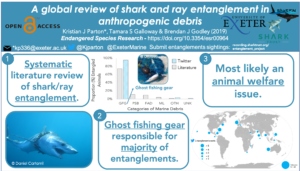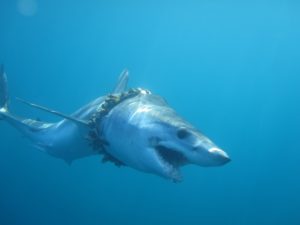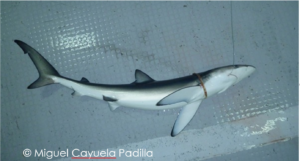For Shark Awareness Day 2019 we have been chatting to a few of our elasmobranch (that’s sharks, skates and rays) researchers here the the University of Exeter! In this blog we talk to Kristian Parton one of our Masters by Research students based at our Penryn Campus. He has recently published his first research paper giving a global overview of shark and ray entanglement. Below he tells us about his research and what he has found.
Words by Kristian Parton, Masters by Research Student at the University of Exeter, Penryn Campus
Numerous shark populations around the world are under-threat from a variety human impacts, the most notable of these being overexploitation and bycatch. Plastic pollution and marine debris is also an ever-growing threat to species inhabiting the marine environment, having direct impacts on fish, sea turtles and marine mammals. There is little existing scientific knowledge on the impacts of marine debris on shark and ray species. Over the last year, I led a team of researchers from the University of Exeter seeking to investigate the impacts of anthropogenic (human-made) marine debris on elasmobranch populations across the globe. Our literature review was published this week in Endangered Species Research, in which we used novel data collection from social media site “Twitter”, as well as pre-existing data in the scientific literature. We discovered that the threat of marine debris to sharks and rays is likely underreported and is without doubt of clear animal welfare concern, although it is unlikely to have wide-ranging detrimental population level effects.

We managed to identify that “ghost fishing gear” was the category of marine debris responsible for entangling the majority of elasmobranchs. Ghost fishing gear is fishing equipment that has been discarded or lost at sea, and is distributed by ocean currents and winds. Ghost gear indiscriminately catches and kills a host of marine life, including sharks and rays. We also discovered the majority of entangled individuals were found in the Atlantic and Pacific oceans, although recommend that more research should also be conducted in the Indian ocean – a known hotspot for elasmobranch biodiversity. In the scientific literature the most common entangled species were lesser spotted dogfish and spiny dogfish, two species regularly found off the coast of Cornwall. We highlight that sharks and rays who have specific habitat niches (e.g. those that inhabit the seafloor or species that occupy open ocean habitats), as well as those who display migratory movements may be at higher risk of entanglement in marine debris.

This Short-fin Mako Shark has been entangled in fishing rope which has caused scoliosis (deformation) of its spine. Image by Daniel Cartamil
By using a novel method of data collection via social media site “Twitter”, we were able to identify several different species of shark and ray that were a victim of entanglement, but weren’t found as entangled in the scientific literature. This included whale sharks, basking sharks and oceanic white-tip sharks. Twitter also highlighted additional entanglements hotspots that again weren’t displayed in the scientific literature.
Although not one of the major threats to sharks and rays, entanglement in marine debris still presents a risk to elasmobranchs, particularly from an animal welfare perspective. With further research on the topic, it could be revealed that this is occurring at far higher levels than we have reported. Social media has now become integrated into today’s society, so using it in a positive way to help reveal additional entanglement reports is a real bonus. With millions of users, the global reach of social media is unprecedented and scientists could now start to tap into the virtual databases that exist on the web.

From this research, we have set up an online entanglement report form in collaboration with the Shark Trust. This will allow citizen scientists across the globe to submit their shark and ray entanglement sightings, and will significantly help scientist further quantify this risk to ever declining elasmobranch populations.
Follow Kris on Twitter.
#ExeterMarine is an interdisciplinary group of marine related researchers with capabilities across the scientific, biological, medical, engineering, humanities and social science fields.
Find us on: Facebook : Twitter : Instagram : LinkedIn
If you are interested in working with our researchers or students, contact Michael Hanley or visit our website!
